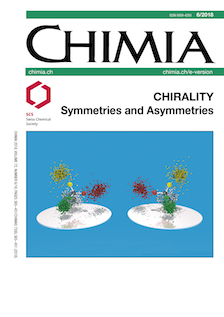Conformational Study and Chiroptical Properties of Chiral Dimethyl-Ethylenedithio-Tetrathiafulvalene (DM-EDT-TTF)
DOI:
https://doi.org/10.2533/chimia.2018.389Keywords:
Chirality, Circular dichroism, Dft calculations, Free energy surface analysis, TetrathiafulvalenesAbstract
The enantiopure dimethyl-ethylenedithio-tetrathiafulvalene (DM-EDT-TTF) donor exists as biaxial (ax, ax) and biequatorial (eq, eq) conformers in equilibrium. DFT calculations combined with free energy surface (FES) analysis establish that the (ax, ax) form is more stable by ?0.7 kcal·mol–1 than the (eq, eq) one and that the inter-conversion process involves a sequential conformational change through a boat type (ax, eq) conformer with an activation energy of ?3 kcal.mol–1. TD-DFT calculations show similar, but opposite in sign, CD bands for the two conformers. A Boltzmann type average of the two CD curves, corresponding to a ratio of three (ax, ax) for one (eq, eq) conformers in equilibrium in solution, provides an excellent agreement with the experimental curve.Downloads
Published
2018-06-27
Issue
Section
Scientific Articles
License
Copyright (c) 2018 Swiss Chemical Society

This work is licensed under a Creative Commons Attribution-NonCommercial 4.0 International License.
How to Cite
[1]
Chimia 2018, 72, 389, DOI: 10.2533/chimia.2018.389.







